Decline of Trade Union Membership in Australia: An Analysis Report
VerifiedAdded on 2023/01/16
|9
|2779
|60
Report
AI Summary
This report provides a comprehensive analysis of the significant decline in trade union membership in Australia over the past two decades. It explores the changing industrial relations environment, including legislative changes, the rise of workplace-level agreements, and the impact on union power. The report examines the decline across various demographics, including age groups, sectors, and employment types, highlighting the shift towards part-time and non-unionized employment. It delves into the structural changes in the labor market, institutional factors, and new employer strategies that have contributed to this decline. The report also compares Australia's unionization rates with those of other OECD countries and discusses the implications of these trends for Australian society. The report concludes by considering the future of unions and the challenges they face in a changing economic and social landscape.
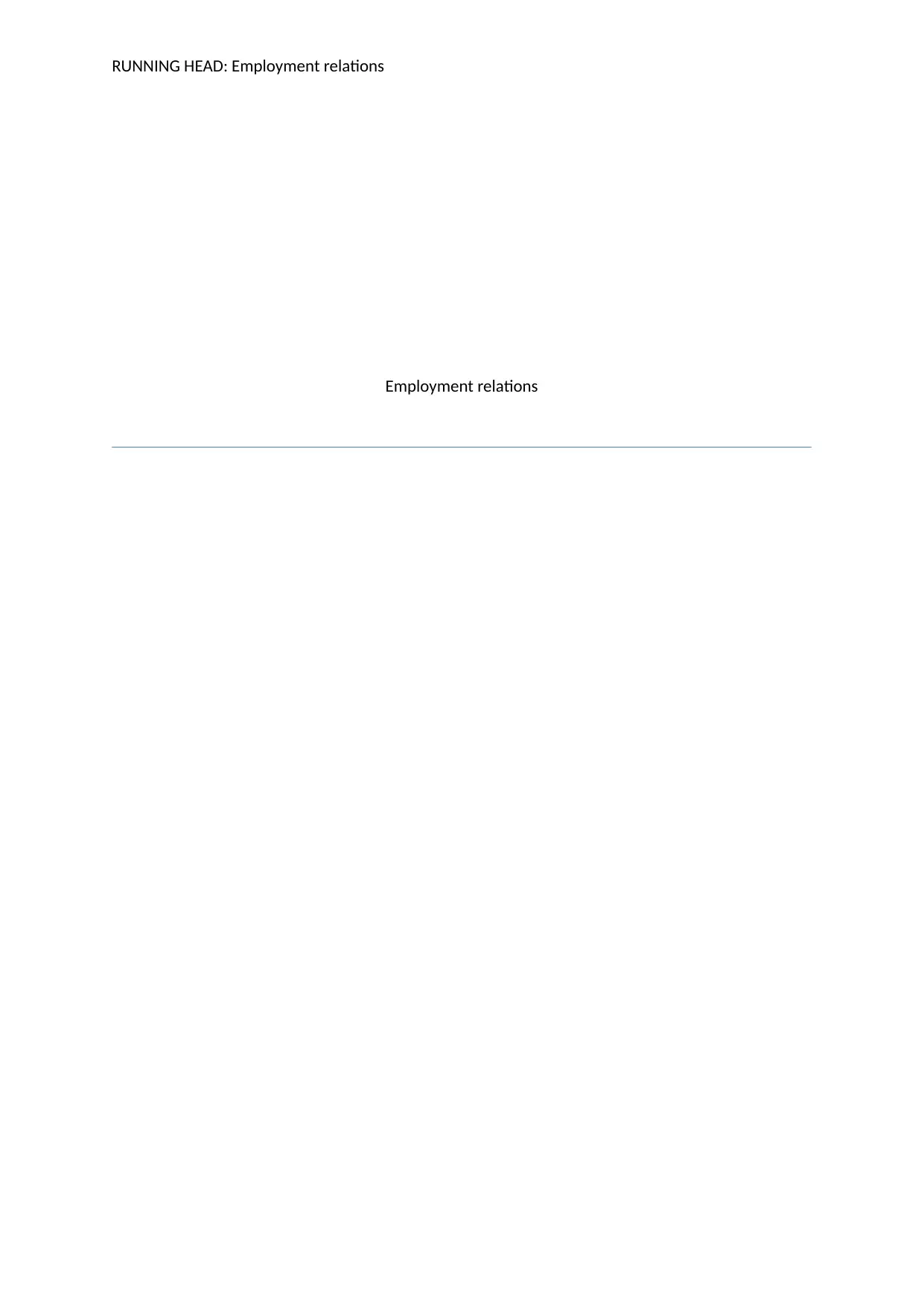
RUNNING HEAD: Employment relations
Employment relations
Employment relations
Paraphrase This Document
Need a fresh take? Get an instant paraphrase of this document with our AI Paraphraser
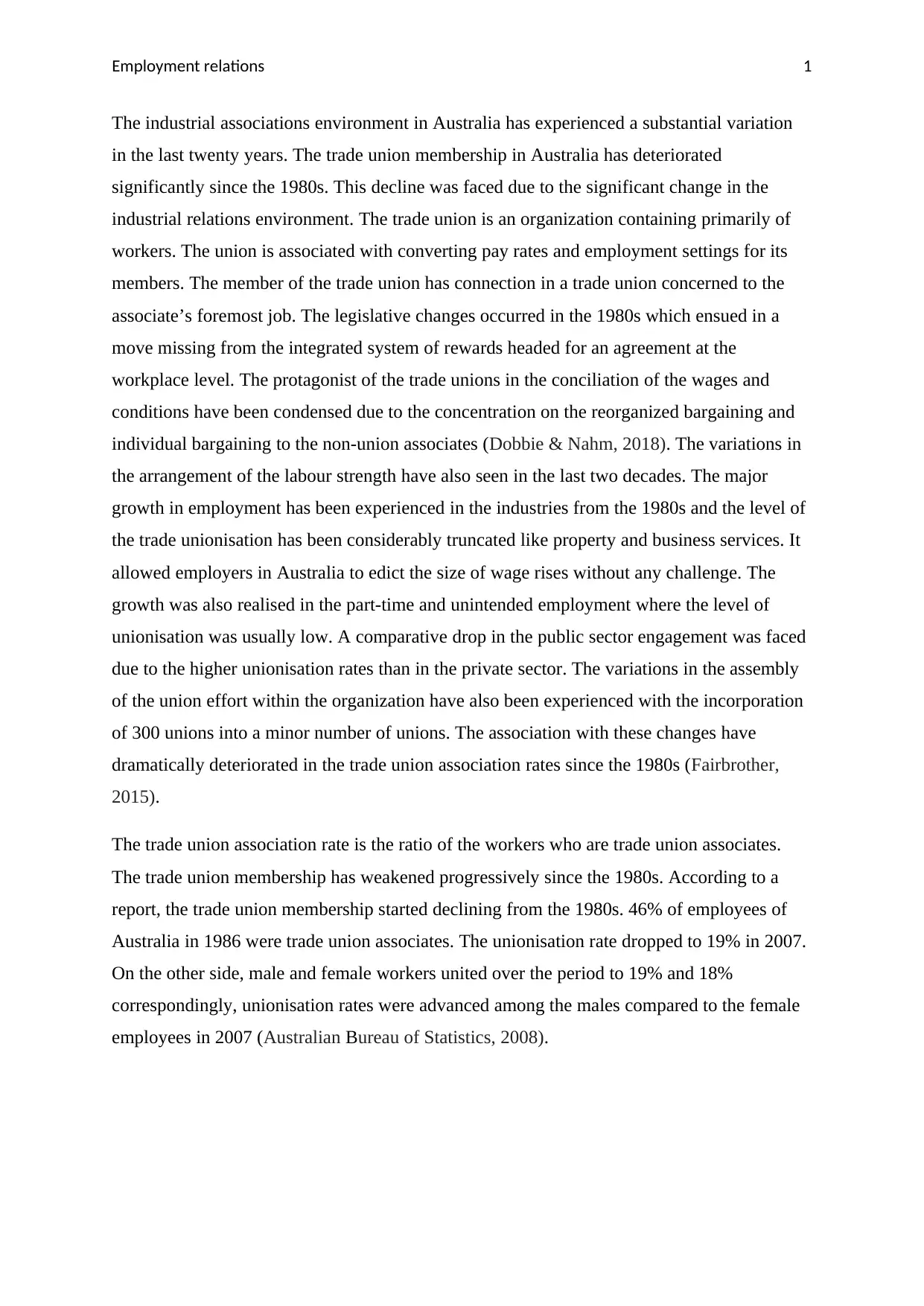
Employment relations 1
The industrial associations environment in Australia has experienced a substantial variation
in the last twenty years. The trade union membership in Australia has deteriorated
significantly since the 1980s. This decline was faced due to the significant change in the
industrial relations environment. The trade union is an organization containing primarily of
workers. The union is associated with converting pay rates and employment settings for its
members. The member of the trade union has connection in a trade union concerned to the
associate’s foremost job. The legislative changes occurred in the 1980s which ensued in a
move missing from the integrated system of rewards headed for an agreement at the
workplace level. The protagonist of the trade unions in the conciliation of the wages and
conditions have been condensed due to the concentration on the reorganized bargaining and
individual bargaining to the non-union associates (Dobbie & Nahm, 2018). The variations in
the arrangement of the labour strength have also seen in the last two decades. The major
growth in employment has been experienced in the industries from the 1980s and the level of
the trade unionisation has been considerably truncated like property and business services. It
allowed employers in Australia to edict the size of wage rises without any challenge. The
growth was also realised in the part-time and unintended employment where the level of
unionisation was usually low. A comparative drop in the public sector engagement was faced
due to the higher unionisation rates than in the private sector. The variations in the assembly
of the union effort within the organization have also been experienced with the incorporation
of 300 unions into a minor number of unions. The association with these changes have
dramatically deteriorated in the trade union association rates since the 1980s (Fairbrother,
2015).
The trade union association rate is the ratio of the workers who are trade union associates.
The trade union membership has weakened progressively since the 1980s. According to a
report, the trade union membership started declining from the 1980s. 46% of employees of
Australia in 1986 were trade union associates. The unionisation rate dropped to 19% in 2007.
On the other side, male and female workers united over the period to 19% and 18%
correspondingly, unionisation rates were advanced among the males compared to the female
employees in 2007 (Australian Bureau of Statistics, 2008).
The industrial associations environment in Australia has experienced a substantial variation
in the last twenty years. The trade union membership in Australia has deteriorated
significantly since the 1980s. This decline was faced due to the significant change in the
industrial relations environment. The trade union is an organization containing primarily of
workers. The union is associated with converting pay rates and employment settings for its
members. The member of the trade union has connection in a trade union concerned to the
associate’s foremost job. The legislative changes occurred in the 1980s which ensued in a
move missing from the integrated system of rewards headed for an agreement at the
workplace level. The protagonist of the trade unions in the conciliation of the wages and
conditions have been condensed due to the concentration on the reorganized bargaining and
individual bargaining to the non-union associates (Dobbie & Nahm, 2018). The variations in
the arrangement of the labour strength have also seen in the last two decades. The major
growth in employment has been experienced in the industries from the 1980s and the level of
the trade unionisation has been considerably truncated like property and business services. It
allowed employers in Australia to edict the size of wage rises without any challenge. The
growth was also realised in the part-time and unintended employment where the level of
unionisation was usually low. A comparative drop in the public sector engagement was faced
due to the higher unionisation rates than in the private sector. The variations in the assembly
of the union effort within the organization have also been experienced with the incorporation
of 300 unions into a minor number of unions. The association with these changes have
dramatically deteriorated in the trade union association rates since the 1980s (Fairbrother,
2015).
The trade union association rate is the ratio of the workers who are trade union associates.
The trade union membership has weakened progressively since the 1980s. According to a
report, the trade union membership started declining from the 1980s. 46% of employees of
Australia in 1986 were trade union associates. The unionisation rate dropped to 19% in 2007.
On the other side, male and female workers united over the period to 19% and 18%
correspondingly, unionisation rates were advanced among the males compared to the female
employees in 2007 (Australian Bureau of Statistics, 2008).
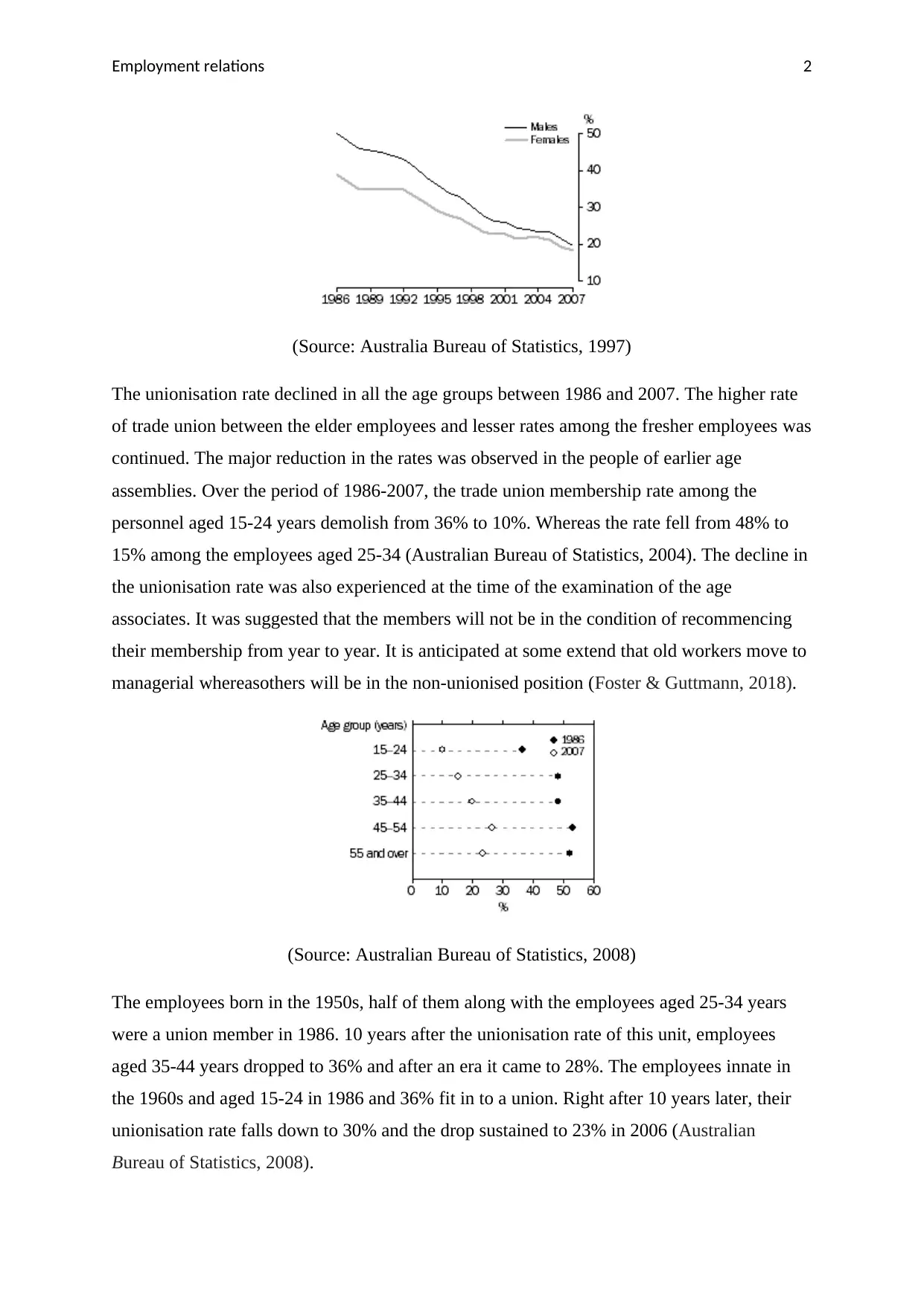
Employment relations 2
(Source: Australia Bureau of Statistics, 1997)
The unionisation rate declined in all the age groups between 1986 and 2007. The higher rate
of trade union between the elder employees and lesser rates among the fresher employees was
continued. The major reduction in the rates was observed in the people of earlier age
assemblies. Over the period of 1986-2007, the trade union membership rate among the
personnel aged 15-24 years demolish from 36% to 10%. Whereas the rate fell from 48% to
15% among the employees aged 25-34 (Australian Bureau of Statistics, 2004). The decline in
the unionisation rate was also experienced at the time of the examination of the age
associates. It was suggested that the members will not be in the condition of recommencing
their membership from year to year. It is anticipated at some extend that old workers move to
managerial whereasothers will be in the non-unionised position (Foster & Guttmann, 2018).
(Source: Australian Bureau of Statistics, 2008)
The employees born in the 1950s, half of them along with the employees aged 25-34 years
were a union member in 1986. 10 years after the unionisation rate of this unit, employees
aged 35-44 years dropped to 36% and after an era it came to 28%. The employees innate in
the 1960s and aged 15-24 in 1986 and 36% fit in to a union. Right after 10 years later, their
unionisation rate falls down to 30% and the drop sustained to 23% in 2006 (Australian
Bureau of Statistics, 2008).
(Source: Australia Bureau of Statistics, 1997)
The unionisation rate declined in all the age groups between 1986 and 2007. The higher rate
of trade union between the elder employees and lesser rates among the fresher employees was
continued. The major reduction in the rates was observed in the people of earlier age
assemblies. Over the period of 1986-2007, the trade union membership rate among the
personnel aged 15-24 years demolish from 36% to 10%. Whereas the rate fell from 48% to
15% among the employees aged 25-34 (Australian Bureau of Statistics, 2004). The decline in
the unionisation rate was also experienced at the time of the examination of the age
associates. It was suggested that the members will not be in the condition of recommencing
their membership from year to year. It is anticipated at some extend that old workers move to
managerial whereasothers will be in the non-unionised position (Foster & Guttmann, 2018).
(Source: Australian Bureau of Statistics, 2008)
The employees born in the 1950s, half of them along with the employees aged 25-34 years
were a union member in 1986. 10 years after the unionisation rate of this unit, employees
aged 35-44 years dropped to 36% and after an era it came to 28%. The employees innate in
the 1960s and aged 15-24 in 1986 and 36% fit in to a union. Right after 10 years later, their
unionisation rate falls down to 30% and the drop sustained to 23% in 2006 (Australian
Bureau of Statistics, 2008).
⊘ This is a preview!⊘
Do you want full access?
Subscribe today to unlock all pages.

Trusted by 1+ million students worldwide
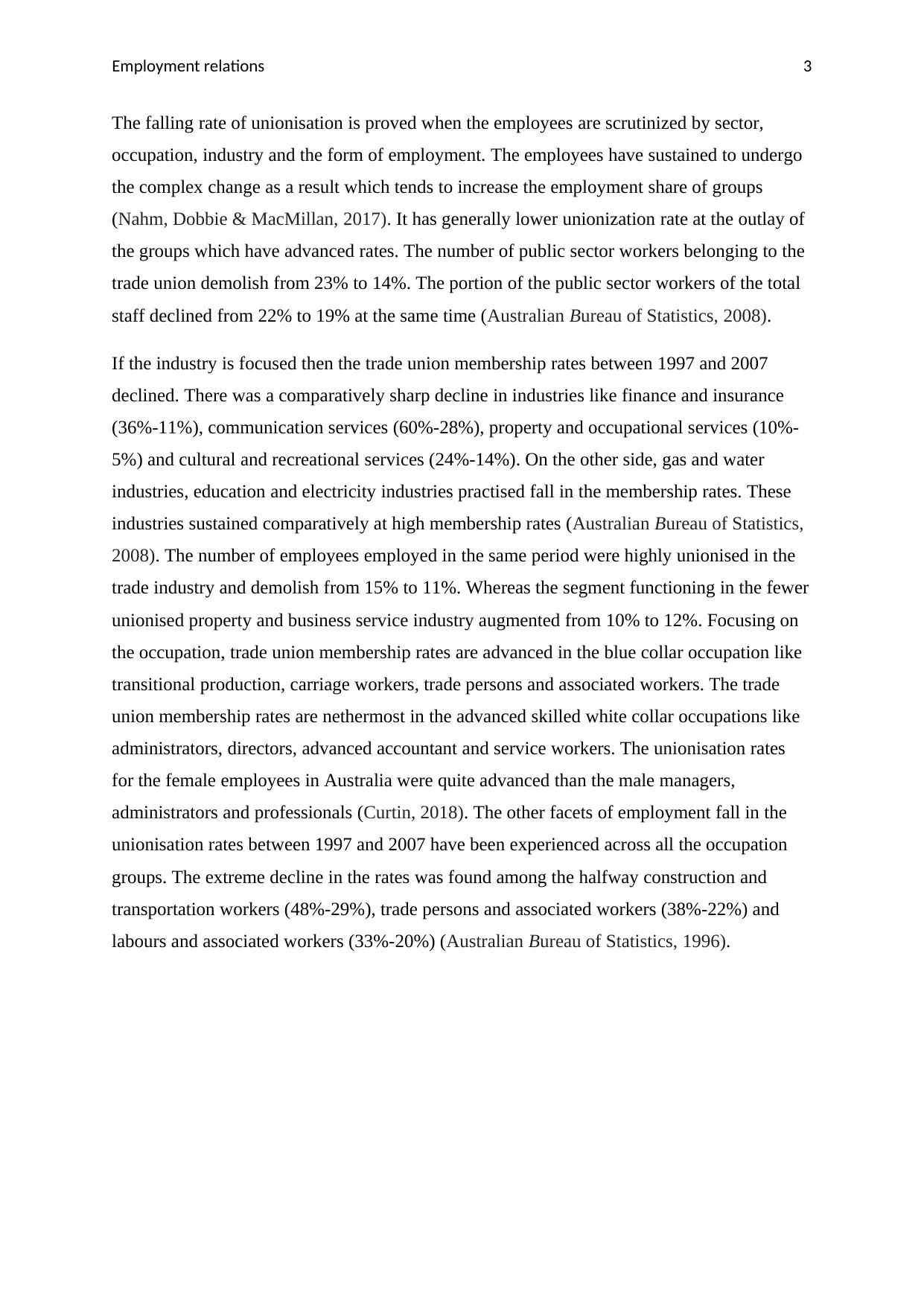
Employment relations 3
The falling rate of unionisation is proved when the employees are scrutinized by sector,
occupation, industry and the form of employment. The employees have sustained to undergo
the complex change as a result which tends to increase the employment share of groups
(Nahm, Dobbie & MacMillan, 2017). It has generally lower unionization rate at the outlay of
the groups which have advanced rates. The number of public sector workers belonging to the
trade union demolish from 23% to 14%. The portion of the public sector workers of the total
staff declined from 22% to 19% at the same time (Australian Bureau of Statistics, 2008).
If the industry is focused then the trade union membership rates between 1997 and 2007
declined. There was a comparatively sharp decline in industries like finance and insurance
(36%-11%), communication services (60%-28%), property and occupational services (10%-
5%) and cultural and recreational services (24%-14%). On the other side, gas and water
industries, education and electricity industries practised fall in the membership rates. These
industries sustained comparatively at high membership rates (Australian Bureau of Statistics,
2008). The number of employees employed in the same period were highly unionised in the
trade industry and demolish from 15% to 11%. Whereas the segment functioning in the fewer
unionised property and business service industry augmented from 10% to 12%. Focusing on
the occupation, trade union membership rates are advanced in the blue collar occupation like
transitional production, carriage workers, trade persons and associated workers. The trade
union membership rates are nethermost in the advanced skilled white collar occupations like
administrators, directors, advanced accountant and service workers. The unionisation rates
for the female employees in Australia were quite advanced than the male managers,
administrators and professionals (Curtin, 2018). The other facets of employment fall in the
unionisation rates between 1997 and 2007 have been experienced across all the occupation
groups. The extreme decline in the rates was found among the halfway construction and
transportation workers (48%-29%), trade persons and associated workers (38%-22%) and
labours and associated workers (33%-20%) (Australian Bureau of Statistics, 1996).
The falling rate of unionisation is proved when the employees are scrutinized by sector,
occupation, industry and the form of employment. The employees have sustained to undergo
the complex change as a result which tends to increase the employment share of groups
(Nahm, Dobbie & MacMillan, 2017). It has generally lower unionization rate at the outlay of
the groups which have advanced rates. The number of public sector workers belonging to the
trade union demolish from 23% to 14%. The portion of the public sector workers of the total
staff declined from 22% to 19% at the same time (Australian Bureau of Statistics, 2008).
If the industry is focused then the trade union membership rates between 1997 and 2007
declined. There was a comparatively sharp decline in industries like finance and insurance
(36%-11%), communication services (60%-28%), property and occupational services (10%-
5%) and cultural and recreational services (24%-14%). On the other side, gas and water
industries, education and electricity industries practised fall in the membership rates. These
industries sustained comparatively at high membership rates (Australian Bureau of Statistics,
2008). The number of employees employed in the same period were highly unionised in the
trade industry and demolish from 15% to 11%. Whereas the segment functioning in the fewer
unionised property and business service industry augmented from 10% to 12%. Focusing on
the occupation, trade union membership rates are advanced in the blue collar occupation like
transitional production, carriage workers, trade persons and associated workers. The trade
union membership rates are nethermost in the advanced skilled white collar occupations like
administrators, directors, advanced accountant and service workers. The unionisation rates
for the female employees in Australia were quite advanced than the male managers,
administrators and professionals (Curtin, 2018). The other facets of employment fall in the
unionisation rates between 1997 and 2007 have been experienced across all the occupation
groups. The extreme decline in the rates was found among the halfway construction and
transportation workers (48%-29%), trade persons and associated workers (38%-22%) and
labours and associated workers (33%-20%) (Australian Bureau of Statistics, 1996).
Paraphrase This Document
Need a fresh take? Get an instant paraphrase of this document with our AI Paraphraser
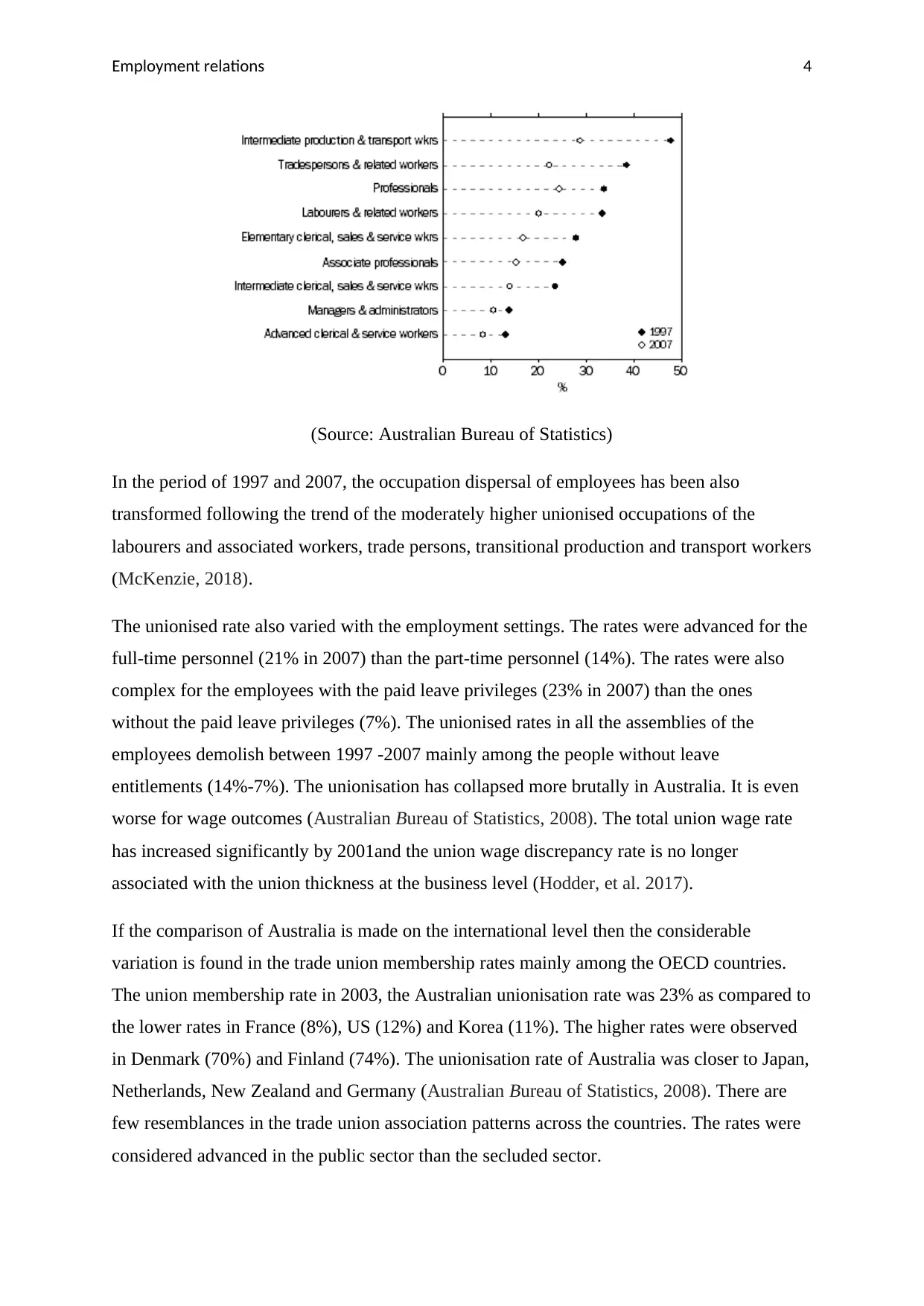
Employment relations 4
(Source: Australian Bureau of Statistics)
In the period of 1997 and 2007, the occupation dispersal of employees has been also
transformed following the trend of the moderately higher unionised occupations of the
labourers and associated workers, trade persons, transitional production and transport workers
(McKenzie, 2018).
The unionised rate also varied with the employment settings. The rates were advanced for the
full-time personnel (21% in 2007) than the part-time personnel (14%). The rates were also
complex for the employees with the paid leave privileges (23% in 2007) than the ones
without the paid leave privileges (7%). The unionised rates in all the assemblies of the
employees demolish between 1997 -2007 mainly among the people without leave
entitlements (14%-7%). The unionisation has collapsed more brutally in Australia. It is even
worse for wage outcomes (Australian Bureau of Statistics, 2008). The total union wage rate
has increased significantly by 2001and the union wage discrepancy rate is no longer
associated with the union thickness at the business level (Hodder, et al. 2017).
If the comparison of Australia is made on the international level then the considerable
variation is found in the trade union membership rates mainly among the OECD countries.
The union membership rate in 2003, the Australian unionisation rate was 23% as compared to
the lower rates in France (8%), US (12%) and Korea (11%). The higher rates were observed
in Denmark (70%) and Finland (74%). The unionisation rate of Australia was closer to Japan,
Netherlands, New Zealand and Germany (Australian Bureau of Statistics, 2008). There are
few resemblances in the trade union association patterns across the countries. The rates were
considered advanced in the public sector than the secluded sector.
(Source: Australian Bureau of Statistics)
In the period of 1997 and 2007, the occupation dispersal of employees has been also
transformed following the trend of the moderately higher unionised occupations of the
labourers and associated workers, trade persons, transitional production and transport workers
(McKenzie, 2018).
The unionised rate also varied with the employment settings. The rates were advanced for the
full-time personnel (21% in 2007) than the part-time personnel (14%). The rates were also
complex for the employees with the paid leave privileges (23% in 2007) than the ones
without the paid leave privileges (7%). The unionised rates in all the assemblies of the
employees demolish between 1997 -2007 mainly among the people without leave
entitlements (14%-7%). The unionisation has collapsed more brutally in Australia. It is even
worse for wage outcomes (Australian Bureau of Statistics, 2008). The total union wage rate
has increased significantly by 2001and the union wage discrepancy rate is no longer
associated with the union thickness at the business level (Hodder, et al. 2017).
If the comparison of Australia is made on the international level then the considerable
variation is found in the trade union membership rates mainly among the OECD countries.
The union membership rate in 2003, the Australian unionisation rate was 23% as compared to
the lower rates in France (8%), US (12%) and Korea (11%). The higher rates were observed
in Denmark (70%) and Finland (74%). The unionisation rate of Australia was closer to Japan,
Netherlands, New Zealand and Germany (Australian Bureau of Statistics, 2008). There are
few resemblances in the trade union association patterns across the countries. The rates were
considered advanced in the public sector than the secluded sector.
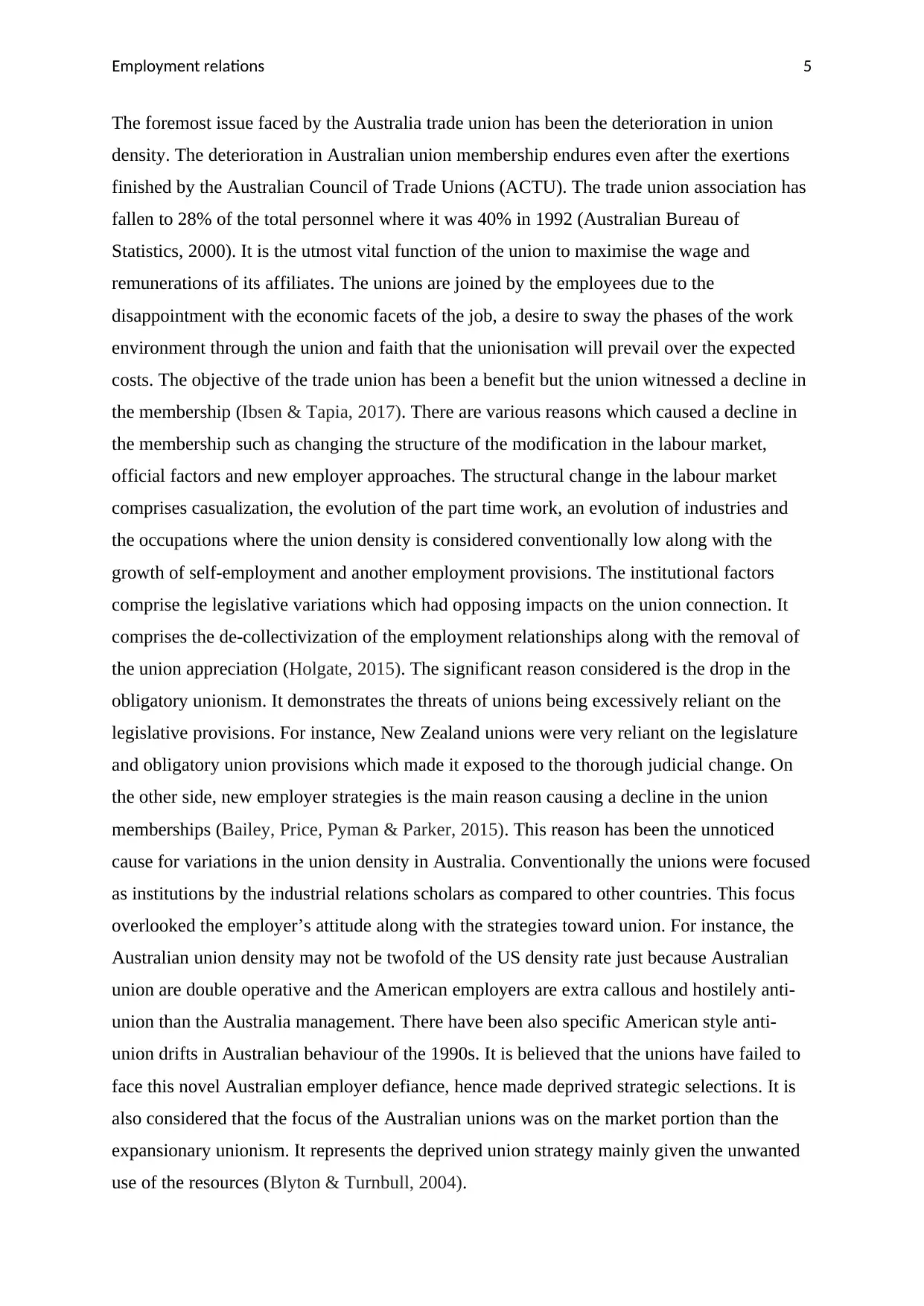
Employment relations 5
The foremost issue faced by the Australia trade union has been the deterioration in union
density. The deterioration in Australian union membership endures even after the exertions
finished by the Australian Council of Trade Unions (ACTU). The trade union association has
fallen to 28% of the total personnel where it was 40% in 1992 (Australian Bureau of
Statistics, 2000). It is the utmost vital function of the union to maximise the wage and
remunerations of its affiliates. The unions are joined by the employees due to the
disappointment with the economic facets of the job, a desire to sway the phases of the work
environment through the union and faith that the unionisation will prevail over the expected
costs. The objective of the trade union has been a benefit but the union witnessed a decline in
the membership (Ibsen & Tapia, 2017). There are various reasons which caused a decline in
the membership such as changing the structure of the modification in the labour market,
official factors and new employer approaches. The structural change in the labour market
comprises casualization, the evolution of the part time work, an evolution of industries and
the occupations where the union density is considered conventionally low along with the
growth of self-employment and another employment provisions. The institutional factors
comprise the legislative variations which had opposing impacts on the union connection. It
comprises the de-collectivization of the employment relationships along with the removal of
the union appreciation (Holgate, 2015). The significant reason considered is the drop in the
obligatory unionism. It demonstrates the threats of unions being excessively reliant on the
legislative provisions. For instance, New Zealand unions were very reliant on the legislature
and obligatory union provisions which made it exposed to the thorough judicial change. On
the other side, new employer strategies is the main reason causing a decline in the union
memberships (Bailey, Price, Pyman & Parker, 2015). This reason has been the unnoticed
cause for variations in the union density in Australia. Conventionally the unions were focused
as institutions by the industrial relations scholars as compared to other countries. This focus
overlooked the employer’s attitude along with the strategies toward union. For instance, the
Australian union density may not be twofold of the US density rate just because Australian
union are double operative and the American employers are extra callous and hostilely anti-
union than the Australia management. There have been also specific American style anti-
union drifts in Australian behaviour of the 1990s. It is believed that the unions have failed to
face this novel Australian employer defiance, hence made deprived strategic selections. It is
also considered that the focus of the Australian unions was on the market portion than the
expansionary unionism. It represents the deprived union strategy mainly given the unwanted
use of the resources (Blyton & Turnbull, 2004).
The foremost issue faced by the Australia trade union has been the deterioration in union
density. The deterioration in Australian union membership endures even after the exertions
finished by the Australian Council of Trade Unions (ACTU). The trade union association has
fallen to 28% of the total personnel where it was 40% in 1992 (Australian Bureau of
Statistics, 2000). It is the utmost vital function of the union to maximise the wage and
remunerations of its affiliates. The unions are joined by the employees due to the
disappointment with the economic facets of the job, a desire to sway the phases of the work
environment through the union and faith that the unionisation will prevail over the expected
costs. The objective of the trade union has been a benefit but the union witnessed a decline in
the membership (Ibsen & Tapia, 2017). There are various reasons which caused a decline in
the membership such as changing the structure of the modification in the labour market,
official factors and new employer approaches. The structural change in the labour market
comprises casualization, the evolution of the part time work, an evolution of industries and
the occupations where the union density is considered conventionally low along with the
growth of self-employment and another employment provisions. The institutional factors
comprise the legislative variations which had opposing impacts on the union connection. It
comprises the de-collectivization of the employment relationships along with the removal of
the union appreciation (Holgate, 2015). The significant reason considered is the drop in the
obligatory unionism. It demonstrates the threats of unions being excessively reliant on the
legislative provisions. For instance, New Zealand unions were very reliant on the legislature
and obligatory union provisions which made it exposed to the thorough judicial change. On
the other side, new employer strategies is the main reason causing a decline in the union
memberships (Bailey, Price, Pyman & Parker, 2015). This reason has been the unnoticed
cause for variations in the union density in Australia. Conventionally the unions were focused
as institutions by the industrial relations scholars as compared to other countries. This focus
overlooked the employer’s attitude along with the strategies toward union. For instance, the
Australian union density may not be twofold of the US density rate just because Australian
union are double operative and the American employers are extra callous and hostilely anti-
union than the Australia management. There have been also specific American style anti-
union drifts in Australian behaviour of the 1990s. It is believed that the unions have failed to
face this novel Australian employer defiance, hence made deprived strategic selections. It is
also considered that the focus of the Australian unions was on the market portion than the
expansionary unionism. It represents the deprived union strategy mainly given the unwanted
use of the resources (Blyton & Turnbull, 2004).
⊘ This is a preview!⊘
Do you want full access?
Subscribe today to unlock all pages.

Trusted by 1+ million students worldwide
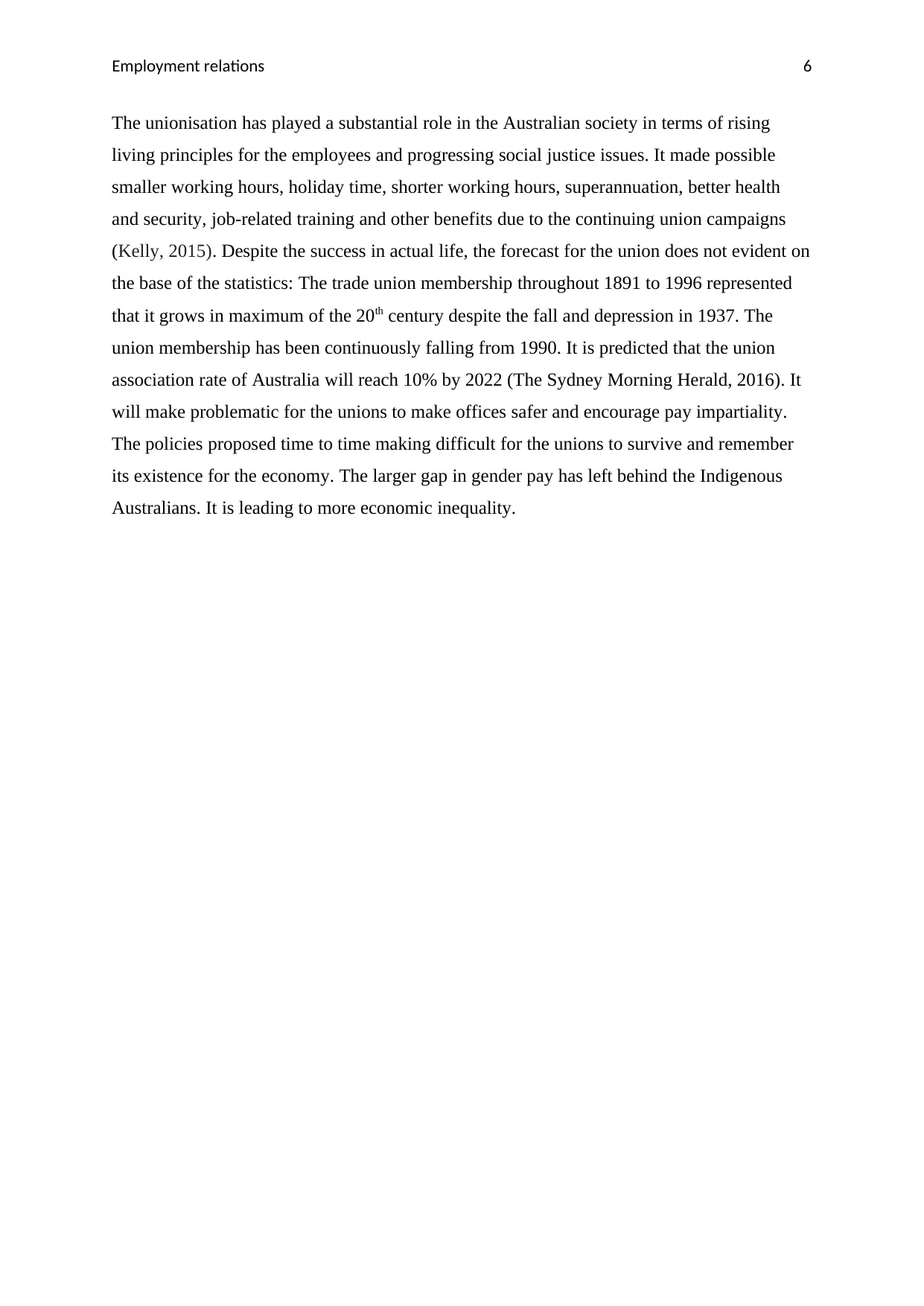
Employment relations 6
The unionisation has played a substantial role in the Australian society in terms of rising
living principles for the employees and progressing social justice issues. It made possible
smaller working hours, holiday time, shorter working hours, superannuation, better health
and security, job-related training and other benefits due to the continuing union campaigns
(Kelly, 2015). Despite the success in actual life, the forecast for the union does not evident on
the base of the statistics: The trade union membership throughout 1891 to 1996 represented
that it grows in maximum of the 20th century despite the fall and depression in 1937. The
union membership has been continuously falling from 1990. It is predicted that the union
association rate of Australia will reach 10% by 2022 (The Sydney Morning Herald, 2016). It
will make problematic for the unions to make offices safer and encourage pay impartiality.
The policies proposed time to time making difficult for the unions to survive and remember
its existence for the economy. The larger gap in gender pay has left behind the Indigenous
Australians. It is leading to more economic inequality.
The unionisation has played a substantial role in the Australian society in terms of rising
living principles for the employees and progressing social justice issues. It made possible
smaller working hours, holiday time, shorter working hours, superannuation, better health
and security, job-related training and other benefits due to the continuing union campaigns
(Kelly, 2015). Despite the success in actual life, the forecast for the union does not evident on
the base of the statistics: The trade union membership throughout 1891 to 1996 represented
that it grows in maximum of the 20th century despite the fall and depression in 1937. The
union membership has been continuously falling from 1990. It is predicted that the union
association rate of Australia will reach 10% by 2022 (The Sydney Morning Herald, 2016). It
will make problematic for the unions to make offices safer and encourage pay impartiality.
The policies proposed time to time making difficult for the unions to survive and remember
its existence for the economy. The larger gap in gender pay has left behind the Indigenous
Australians. It is leading to more economic inequality.
Paraphrase This Document
Need a fresh take? Get an instant paraphrase of this document with our AI Paraphraser
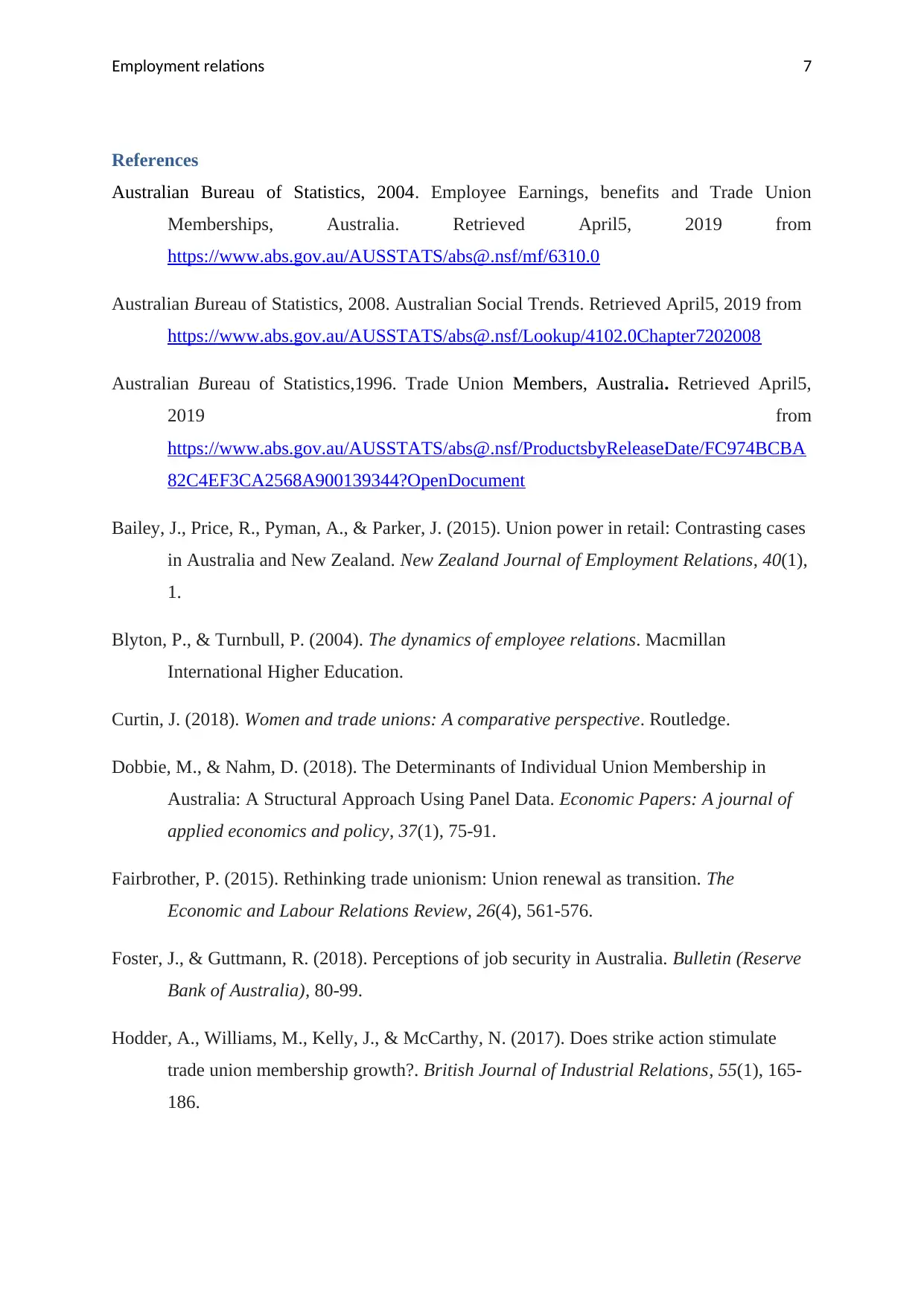
Employment relations 7
References
Australian Bureau of Statistics, 2004. Employee Earnings, benefits and Trade Union
Memberships, Australia. Retrieved April5, 2019 from
https://www.abs.gov.au/AUSSTATS/abs@.nsf/mf/6310.0
Australian Bureau of Statistics, 2008. Australian Social Trends. Retrieved April5, 2019 from
https://www.abs.gov.au/AUSSTATS/abs@.nsf/Lookup/4102.0Chapter7202008
Australian Bureau of Statistics,1996. Trade Union Members, Australia. Retrieved April5,
2019 from
https://www.abs.gov.au/AUSSTATS/abs@.nsf/ProductsbyReleaseDate/FC974BCBA
82C4EF3CA2568A900139344?OpenDocument
Bailey, J., Price, R., Pyman, A., & Parker, J. (2015). Union power in retail: Contrasting cases
in Australia and New Zealand. New Zealand Journal of Employment Relations, 40(1),
1.
Blyton, P., & Turnbull, P. (2004). The dynamics of employee relations. Macmillan
International Higher Education.
Curtin, J. (2018). Women and trade unions: A comparative perspective. Routledge.
Dobbie, M., & Nahm, D. (2018). The Determinants of Individual Union Membership in
Australia: A Structural Approach Using Panel Data. Economic Papers: A journal of
applied economics and policy, 37(1), 75-91.
Fairbrother, P. (2015). Rethinking trade unionism: Union renewal as transition. The
Economic and Labour Relations Review, 26(4), 561-576.
Foster, J., & Guttmann, R. (2018). Perceptions of job security in Australia. Bulletin (Reserve
Bank of Australia), 80-99.
Hodder, A., Williams, M., Kelly, J., & McCarthy, N. (2017). Does strike action stimulate
trade union membership growth?. British Journal of Industrial Relations, 55(1), 165-
186.
References
Australian Bureau of Statistics, 2004. Employee Earnings, benefits and Trade Union
Memberships, Australia. Retrieved April5, 2019 from
https://www.abs.gov.au/AUSSTATS/abs@.nsf/mf/6310.0
Australian Bureau of Statistics, 2008. Australian Social Trends. Retrieved April5, 2019 from
https://www.abs.gov.au/AUSSTATS/abs@.nsf/Lookup/4102.0Chapter7202008
Australian Bureau of Statistics,1996. Trade Union Members, Australia. Retrieved April5,
2019 from
https://www.abs.gov.au/AUSSTATS/abs@.nsf/ProductsbyReleaseDate/FC974BCBA
82C4EF3CA2568A900139344?OpenDocument
Bailey, J., Price, R., Pyman, A., & Parker, J. (2015). Union power in retail: Contrasting cases
in Australia and New Zealand. New Zealand Journal of Employment Relations, 40(1),
1.
Blyton, P., & Turnbull, P. (2004). The dynamics of employee relations. Macmillan
International Higher Education.
Curtin, J. (2018). Women and trade unions: A comparative perspective. Routledge.
Dobbie, M., & Nahm, D. (2018). The Determinants of Individual Union Membership in
Australia: A Structural Approach Using Panel Data. Economic Papers: A journal of
applied economics and policy, 37(1), 75-91.
Fairbrother, P. (2015). Rethinking trade unionism: Union renewal as transition. The
Economic and Labour Relations Review, 26(4), 561-576.
Foster, J., & Guttmann, R. (2018). Perceptions of job security in Australia. Bulletin (Reserve
Bank of Australia), 80-99.
Hodder, A., Williams, M., Kelly, J., & McCarthy, N. (2017). Does strike action stimulate
trade union membership growth?. British Journal of Industrial Relations, 55(1), 165-
186.
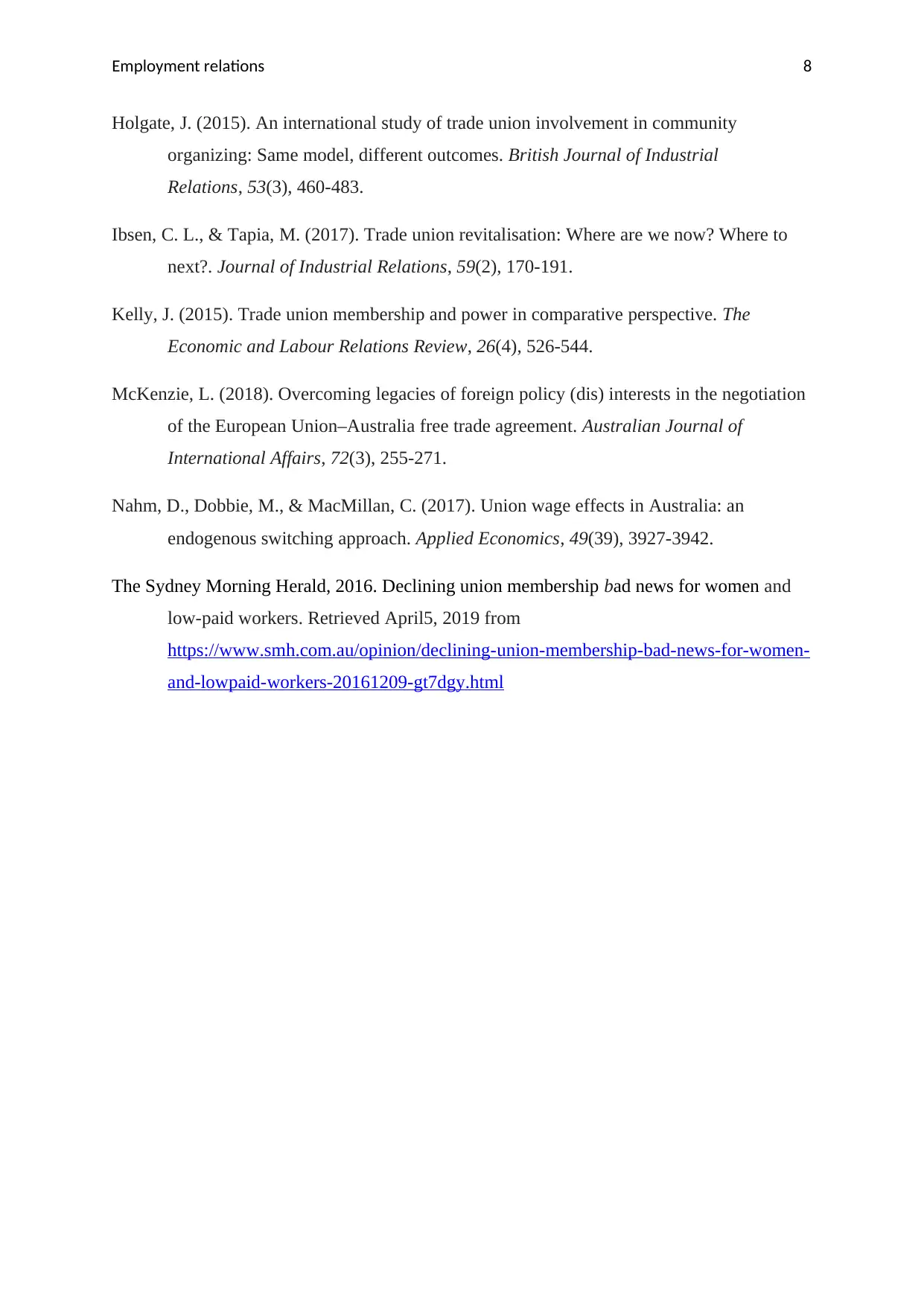
Employment relations 8
Holgate, J. (2015). An international study of trade union involvement in community
organizing: Same model, different outcomes. British Journal of Industrial
Relations, 53(3), 460-483.
Ibsen, C. L., & Tapia, M. (2017). Trade union revitalisation: Where are we now? Where to
next?. Journal of Industrial Relations, 59(2), 170-191.
Kelly, J. (2015). Trade union membership and power in comparative perspective. The
Economic and Labour Relations Review, 26(4), 526-544.
McKenzie, L. (2018). Overcoming legacies of foreign policy (dis) interests in the negotiation
of the European Union–Australia free trade agreement. Australian Journal of
International Affairs, 72(3), 255-271.
Nahm, D., Dobbie, M., & MacMillan, C. (2017). Union wage effects in Australia: an
endogenous switching approach. Applied Economics, 49(39), 3927-3942.
The Sydney Morning Herald, 2016. Declining union membership bad news for women and
low-paid workers. Retrieved April5, 2019 from
https://www.smh.com.au/opinion/declining-union-membership-bad-news-for-women-
and-lowpaid-workers-20161209-gt7dgy.html
Holgate, J. (2015). An international study of trade union involvement in community
organizing: Same model, different outcomes. British Journal of Industrial
Relations, 53(3), 460-483.
Ibsen, C. L., & Tapia, M. (2017). Trade union revitalisation: Where are we now? Where to
next?. Journal of Industrial Relations, 59(2), 170-191.
Kelly, J. (2015). Trade union membership and power in comparative perspective. The
Economic and Labour Relations Review, 26(4), 526-544.
McKenzie, L. (2018). Overcoming legacies of foreign policy (dis) interests in the negotiation
of the European Union–Australia free trade agreement. Australian Journal of
International Affairs, 72(3), 255-271.
Nahm, D., Dobbie, M., & MacMillan, C. (2017). Union wage effects in Australia: an
endogenous switching approach. Applied Economics, 49(39), 3927-3942.
The Sydney Morning Herald, 2016. Declining union membership bad news for women and
low-paid workers. Retrieved April5, 2019 from
https://www.smh.com.au/opinion/declining-union-membership-bad-news-for-women-
and-lowpaid-workers-20161209-gt7dgy.html
⊘ This is a preview!⊘
Do you want full access?
Subscribe today to unlock all pages.

Trusted by 1+ million students worldwide
1 out of 9
Related Documents
Your All-in-One AI-Powered Toolkit for Academic Success.
+13062052269
info@desklib.com
Available 24*7 on WhatsApp / Email
![[object Object]](/_next/static/media/star-bottom.7253800d.svg)
Unlock your academic potential
Copyright © 2020–2025 A2Z Services. All Rights Reserved. Developed and managed by ZUCOL.




